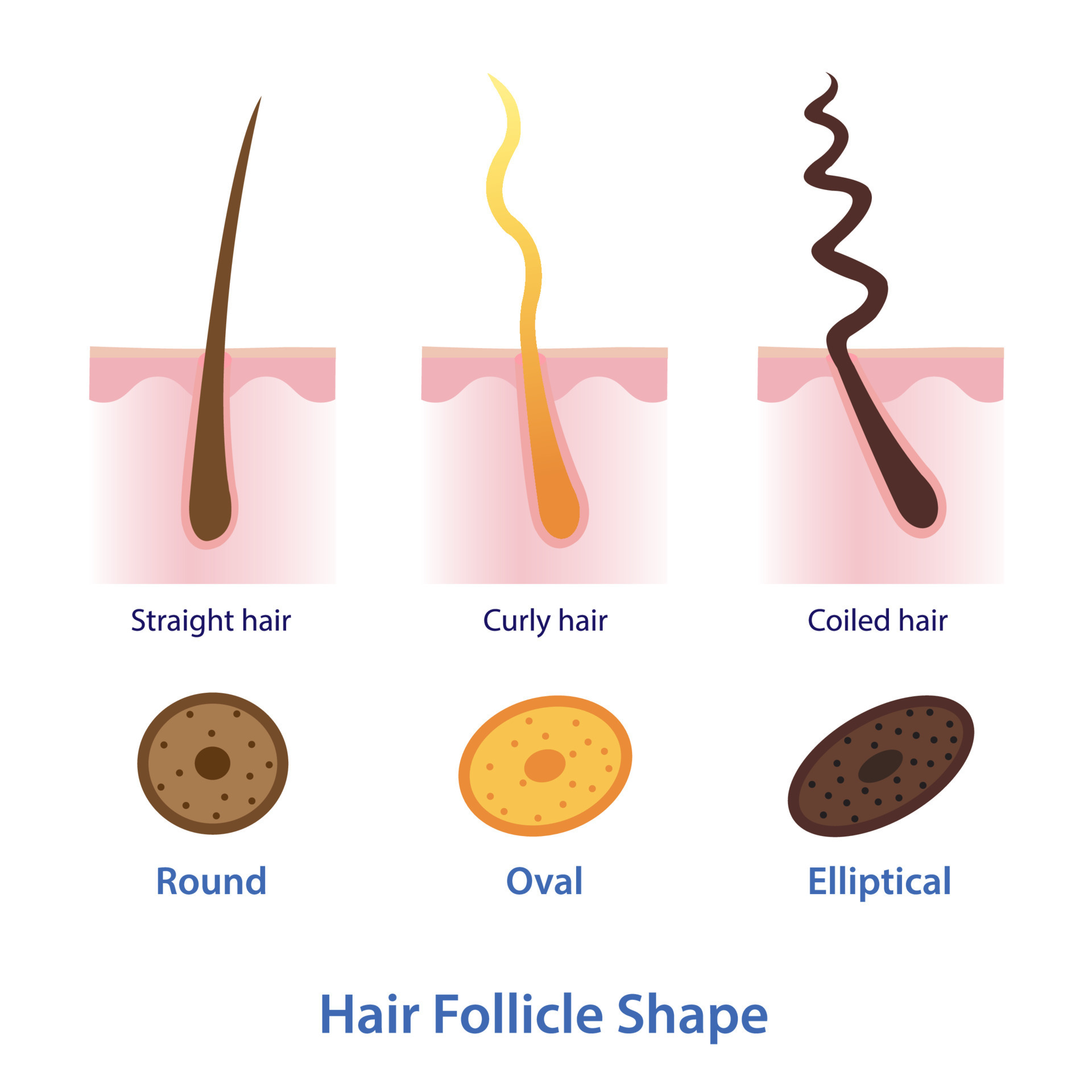Table Of Content

Folliculitis [9] is an inflammation of the hair follicles. Folliculitis can affect the scalp, armpits, face, arms or legs. Folliculitis or hair follicle infection manifests as small red, yellow or white bumps or rashes and may contain pus. Hair from the hair follicle grows to the surface in cycles. Normally, if you pull out hair from a hair follicle, it has the capacity to grow back new hair.
Structure and Function
From straight to curly, thick to thin: here's how hormones and chemotherapy can change your hair - The Conversation France
From straight to curly, thick to thin: here's how hormones and chemotherapy can change your hair.
Posted: Thu, 11 Jan 2024 08:00:00 GMT [source]
Some subjects have genetic relations within the subject pool. In particular, Subject 1 and 2 are daughter and father, Subjects 10 and 11 are fraternal twins, and Subjects 9 and 12 are identical twins. Some features were common in all specimens and assigned to certain molecular components, as explained in the next section. The KEGG results of melatonin regulator genes are shown in Figure 3A.
In brief: What is the structure of hair and how does it grow?
Until recently, the IP of the hair follicle is considered to be restricted to the matrix region during the anagen phase. However, evidence has accumulated that the IP of the hair follicle extends to the bulge region and is present at this site during the entire hair cycle. Since the bulge represents the hair follicle stem cell niche, sustained IP in this region may be essential for the survival of the follicle. Abnormal keratinization causing increased cohesiveness of keratinocytes within the pilosebaceous unit is implicated in both acne vulgaris and keratosis pilaris. Specifically, follicular hyperkeratinization leads to the obstruction of the pilosebaceous unit in acne vulgaris and of hair follicles in keratosis pilaris.
Diseases Associated With Hair Follicles
The rest of the hair, which is anchored in the follicle, lies below the surface of the skin and is referred to as the hair root. The hair root ends deep in the dermis at the hair bulb, and includes a layer of mitotically active basal cells called the hair matrix. The hair bulb surrounds the hair papilla, which is made of connective tissue and contains blood capillaries and nerve endings from the dermis (Figure 1). The perifollicular sheath collapses and vitreous membrane thickens. Eventually, the lower hair follicle becomes reduced to an epithelial strand, bringing the dermal papilla into close proximity of the bulge [36].
Do hair follicles heal after an injury and will my hair grow back?
The results of the effect of melatonin on cashmere production in goats are considered credible. However, more research is needed to support this conclusion. Post traumatic stress can cause the follicles to go into telogen or resting phase prematurely.
Hair Growth
The cut-out at the middle of the apparatus is where scattering occurs on the hair sample. The cardboard apparatus is then mounted vertically onto the loading plate of the Biological Large Angle Diffraction Experiment (BLADE) using sticky putty as shown in Fig. All hair samples were measured at room temperature and humidity of 22 °C and 50% RH. The results of this network meta-analysis are shown in Figures 2A, B. Adding melatonin to the in vitro culture medium was positively correlated with the development of goat oocytes to blastocysts. Neither melatonin plus luzindole nor cysteamine showed correlations in this process.
Outer root sheath
Autonomic nervous innervation primarily provides control of the arrector pili muscle. Hair is continually shed and renewed by the operation of alternating cycles of growth, rest, fallout, and renewed growth. The average life of different varieties of hair varies from about four months for downy hairs to three to five years for long scalp hairs. Each human follicle follows this cycle independently of others, so the total amount of hair remains constant; some animals’ hair follicles have synchronous cycles, causing periodic shedding, or molts. The layers keratinize by forming trichohyalin granules; this is unlike the hair shaft, which undergoes trichilemmal keratinization. The outermost layer of the IRS (Henle layer) keratinizes first because it is lowest in the hair follicle.
More sebum is produced during puberty, which is why acne is common during the teen years. Sebum decreases with age, causing the skin to become dry. It explains how it grows, what it’s made of, and how it changes. If you have conditions like alopecia or balding, you might wonder if it’s possible to stimulate a hair follicle to regrow hair. While your hair color can change throughout your life, your hair follicle, which is part of your skin, is the same color as your natural skin tone. The color of your hair follicle doesn’t relate to the color of your hair.
Categen (transitional phase)

The cells of the innermost layer (IRS cuticle) point downward and inward and interconnect with the cells of the hair cuticle. These 2 cuticles are completely integrated and keratinize after the Henle layer. The middle layer (Huxley layer) keratinizes after the IRS cuticle and the hair cuticle. There is less interest for the mechanism of the hair shedding but from the patient’s perspective it is probably the most important part of the hair growth. It is not unusual for human telogen hairs to be retained from more than one follicular cycle and this suggests that anagen and exogen phases are independent. The shedding period is believed to be an active process and independent of telogen and anagen thus this distinct shedding phase is named exogen [16, 33].
We note that these peaks are related to generic α-helical coil structures of monomeric proteins, and not specific to a certain type of protein. Melatonin can interact with enzymes, molecular channels, transporters, and signaling molecules to perform physiological functions (45, 55). This study only considered melatonin receptor 1A, and this has some limitations. In addition, there is very limited research on human secondary follicles and melatonin.
The full strand of hair develops from this group of hardened hair cells. Because new hardened cells keep on attaching to the hair from below, it is gradually pushed up out of the skin. In this way, a single hair on your head grows at a rate of about 1 cm per month. Facial hair, and especially eyelashes, eyebrows and body hair grows at a slower pace.
The hair is surrounded by the cuticle, a dead cell layer. The common features observed in the X-ray data of all specimens are signals related to the coiled-coil keratin phase and the formation of intermediate filaments in the cortex, and the cell membrane complex. Signal assignment and corresponding length scales are shown in the figure.
The histologic features of the hair follicle change continuously and considerably during the hair growth cycle, thereby making follicular anatomy an even more complex entity. Hair development is a continuous cyclic process and all mature follicles go through a growth cycle consisting of growth (anagen), regression (catagen), rest (telogen) and shedding (exogen) phases (Figure 3). The duration of the phases changes based on the location of the hair and also personal nutritional and hormonal status and age [15, 33].
Follicular epithelium, mesenchyme, neuroectodermal cell populations and also perifollicular vascular and neural systems demonstrates cyclic changes in differentiation and apoptosis. However, any apoptosis is occurred in dermal papilla due to the expression of suppressor bcl-2 [11]. In contrast to the continuous melanogenesis observed in epidermal melanocytes, follicular melanogenesis is a cyclic phenomenon. It is ceased in early the anagen-catagen transition, restarted with the down-regulation of key enzymes of melanogenesis, followed by hair follicle melanocyte apoptosis. Over the course of a few weeks, the hair growth rate slows down and the hair follicle shrinks. The germinal matrix, which is also referred to as the "matrix," is where cells produce new hairs as hairs die and fall out.






















